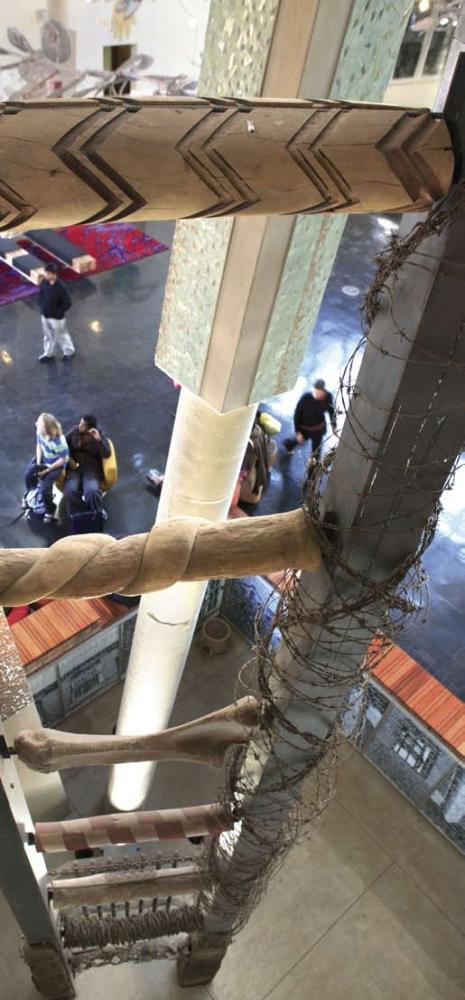Through the Barrier - 1956 Treason Trial Frieze and Ladder
| CCAC #: | 0207 |
| Artwork title: | Through the Barrier - 1956 Treason Trial Frieze and Ladder |
| Artist(s): |
Georgia Papageorge |
| Contributor(s): |
Charl van der Merwe |
| Year made: | 2004 |
| Artwork type: | Sculpture or object |
| Medium: | Mixed media with photographic prints |
| Dimensions (mm): | 810.5 x 1250.5 |
| Source: | Commissioned through a limited competition for the site by the Architectural Artworks Committee as part of the building’s construction |
| Year acquired: | 2005 |
| Installation type: | Integrated artwork |
| Current location: | On public display |
| Signage: | The ‘ladder of freedom’ is placed next to the ‘staircase of oppression’, telling the story of South Africa’s climb from tyranny and fear to freedom and democracy. The ladder stands in the basement of the original Awaiting Trial Block, which has been incorporated into the Constitutional Court’s architecture. According to the artist in the context of this site, the makeup of the ladder becomes a symbol of transcendence and commemoration. The concept of oppression is reflected specifically in the lower sections of the ladder. The lowest part of the ladder is made up of gold reef conglomerate. The value of gold, on which Johannesburg and South Africa’s economy was built, contrasts starkly to the appalling conditions in the early gold mines where many lost their lives. The barbed wire rungs are an emblem of imprisonment and comes from the demolished prison cells of the Old Fort site. The South African Railways (SAR) coach screws of the lower sections are SAR dated, several of those used bearing relevant historical dates. These dates include 1956, the year of the Women’s March against apartheid pass laws for black women, and 1964, the year of the Rivonia Treason Trial that sentenced Nelson Mandela and others to life imprisonment. Moving past the symbols of oppression, the red and white painted chevron rung symbolises the passage through the barriers into transcendence. The elephant bone symbolises memory and dignity, especially of those who suffered and died to bring about a new South Africa. The bone was donated from an elephant that had died of natural causes in the Kruger National Park. The snake rung carved from African Knobthorn symbolises eternity. At the top one finds the chevroned rung made of leadwood from Zimbabwe. The artist explains: “The ubiquitous African chevron symbol links to the red and white Chevron rung, echoing a triumphant passage through barriers of ordinary human resistance.” The photographic series surrounding the artwork, forming part of the installation, is layered with white paint stating the names of the 156 Treason Trial detainees who were kept in holding on this site, also in 1956. They were part of the many others who were kept in the prisons on the Constitution Hill precinct, as it is known today. |

Photographer: Unrecorded
Photo copyright: Consult with CCT curatorial team
NOTE: The process of photographing artworks in the CCAC is underway - we are currently working to improve image quality and display on the CMS but have included internal reference photos for identification purposes in the interim.